Anteaters are cute-looking creatures living in Central and South America that feed on ants and termites. One of their most noticeable body traits is the long and tapered snout they use to grab those insects.
But what about other creatures similar to them? Are there animals that look like anteaters?
Believe it or not, there are plenty of such.
Pangolins, tapirs, armadillos, and aardvarks are the animals that resemble anteaters the most. Some similarities in looks can be also found between anteaters and South American coati, long-beaked echidna, saiga antelope, weevils, some turtles, and even elephants.
Let’s explore all 17 of these anteater-looking animals and see their characteristics and what makes them look so alike.
Table of Contents
At A Glance – Anteater Types
There are 4 species of anteaters: Giant anteater, Silky anteater, Southern Tamandua, and Northern Tamandua.
All of them have strong digging arms, long tongues, and toothless snouts that help them eat up to 35,000 ants a day! Here’s how two of them look.
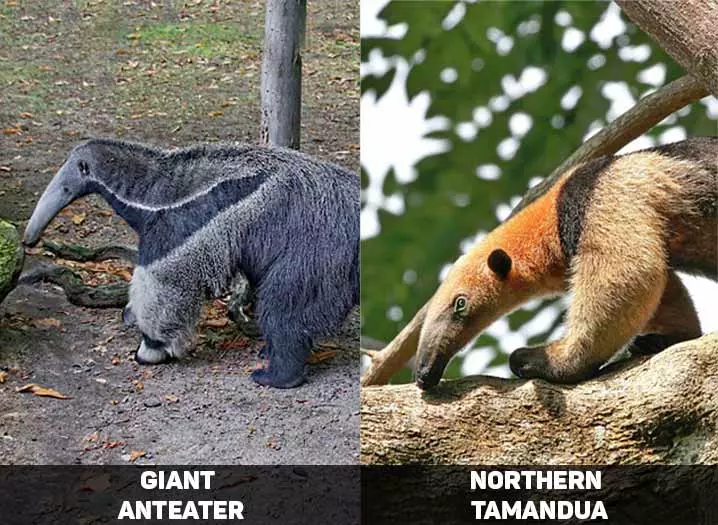
Animals That Look Like Anteaters
Pangolin
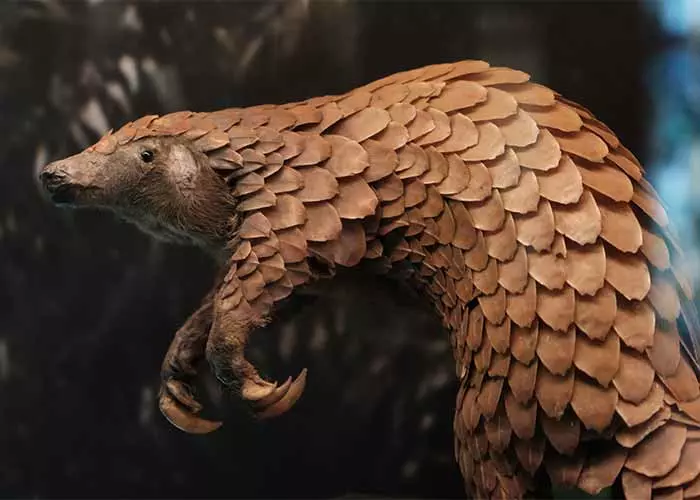
Size: 12-39 in
Weight: 3.5-7.3 lb
Diet: Carnivore
Found In: Asia and Africa
Pangolins are sometimes called scaly anteaters, and no wonder why. Just like anteaters, they have elongated snouts and tongues they use to eat ants and termites with. One could easily say that pangolins look like anteaters covered in tough armored scales.
Despite their similar looks, pangolins and anteaters are not that closely related animals. Anteaters belong to the order Pilosa while pangolins are members of the Pholidota order.
They are the most trafficked mammals in the world: in the last 10 years, over a million pangolins have been illegally taken from the wild and used for food and medicine.
There are 8 species of pangolins: four of them live in Asia and four in Africa.
Read More: More examples of brown-colored animals
Tapir

Size: 5.9-8.2 ft
Weight: 300-700 lb
Diet: Herbivore
Found In: South and Central America, Southeast Asia
Tapirs are large nocturnal mammals with heavy, strong bodies and big snouts, just like the anteaters. Despite having a long and prehensile nose trunk, unlike anteaters, they do not feed on insects. Tapirs are herbivores and feed on leaves, grasses, fruits, and berries.
A tapir may look like an anteater, but they aren’t closely related. Instead, tapirs are related to rhinos and horses. Anteaters are, believe it or not, closely related to sloths.
There are 34 species of tapir today. A tapir that resembles anteaters the most is the one with the longest snout, the Malayan tapir.
Aardvark
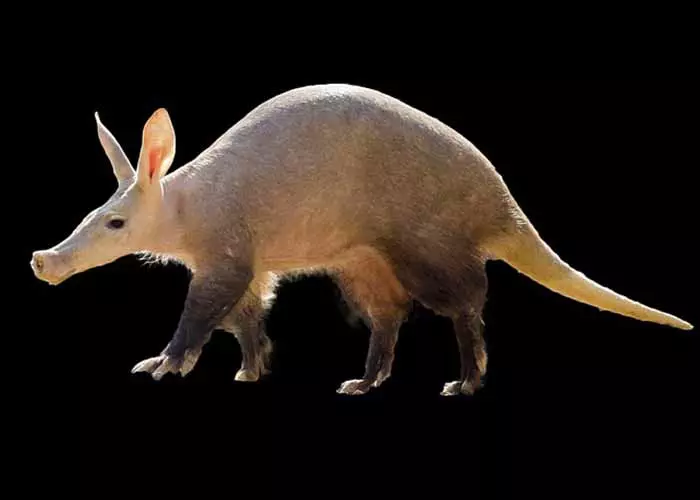
Size: 3.3-4.3 ft
Weight: 90-140 lb
Diet: Omnivore
Found In: Southern Africa
Aardvarks are medium-sized alien-looking nocturnal mammals that have long ears and live in Africa.
People often mistake aardvarks for anteaters due to their long tubular snout, extensible tongue, and similar size. Oh, and you will find both burrowing the ground in pursuit of food – both love to feed on ants and termites.
Both of them are excellent diggers but have a poor sense of vision. What they both have though, is an excellent sense of smell that helps them find their next meal.
However, despite looking alike, they are different species. Aardvarks belong to a completely different order called Tubulidentata.
Due to its burrowing habits and slight similarity with a pig, the aardvark got its name from the word “erdvark” which means “earth pig” or “ground pig” in Afrikaans.
And if you open an English dictionary, “aardvark” is the first word you will find.
Armadillo

Size: 15-23 in
Weight: 8-17 lb
Diet: Omnivore
Found In: South America
Armadillos are other armored animals that look a bit like anteaters. Just like the pangolin, it is covered in thick plates that protect the animal against predators.
The long-nosed armadillos, as their name suggests, have long sticky tongues and pointy snouts. And just like anteaters, they feed on ants and termites.
Armadillo’s snout is significantly shorter than anteater’s but still gives a similar impression. It is no wonder people sometimes mistake these two animals for one another.
These two animals are related – anteaters are the armadillos’ closest relatives, together with sloths.
Armadillos got their names from the Spanish word “armadillo” which means “little armored one”.
South American Coati

Size: 16-28 in
Weight: 4-16 lb
Diet: Omnivore
Found In: South America
Nasua nasua (South American Coati) is a species of mammal that belongs to the raccoon family. The most notable feature of a coati is the long, pointed snout. It seems similar to the one of an anteater, only shorter.
Their Latin name (Nasua) comes from the Latin word for ‘nose’, referring to the long snout. Their common name (Coati) comes from the way these animals sleep – they tuck their nose into their belly.
They are good swimmers, excellent climbers, and often babysit one another’s offspring. Coatis are vital in controlling insect populations and helping disperse fruit; this is key for the survival of certain plants.
Long-beaked Echidna

Size: 31 in
Weight: 36 lb
Diet: Insectivore
Found In: New Guinea
The long-beaked echidna is thought to be the earth’s oldest living mammal. It is an egg-laying animal that lives in New Guinea.
It has short spines scattered among its coarse hairs, and a long boney tube called a “beak” it uses to eat insects and earthworms. That tube is what makes echidnas appear similar to anteaters.
There are 3 species of long-beaked echidna: the Eastern one is listed as vulnerable, while Sir David’s and the Western one are critically endangered.
Mole

Size: 4-7 in
Weight: 0.15-0.28 lb
Diet: Carnivore
Found In: Worldwide
These small mammals are found on every continent except Antarctica and South America. Moles can be found in grasslands, urban areas, gardens, or any area that has soil where they can dig tunnels.
Moles have curved front paws and claws that can dig up to 18 feet in one hour. And despite what many people think, they are not blind – their eyes are simply very small, covered in fur, and hard to spot.
Moles resemble anteaters the most due to their elongated snouts.
Black and Rufous Elephant Shrew
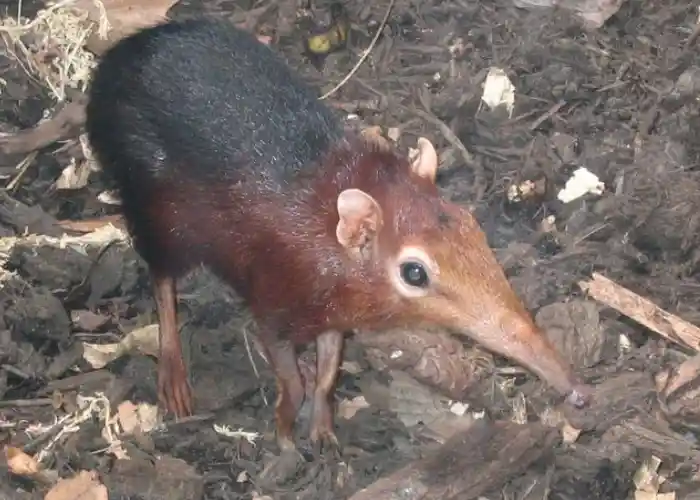
Size: 9-12 in
Weight: 1-1.5 lb
Diet: Carnivore
Found In: Africa
Because of their reddish-brown and black fur, black and rufous elephant shrews resemble northern tamandua the most.
These small mammals with long snouts are one of the 17 species of elephant shrews found only in Africa. Black and rufous elephant shrews use their long proboscises to turn over leaf litter and dig up beetles, and their long tongues to scoop up bugs.
These anteater-like animals are monogamous, often defending hectare-sized territories.
Bandicoot
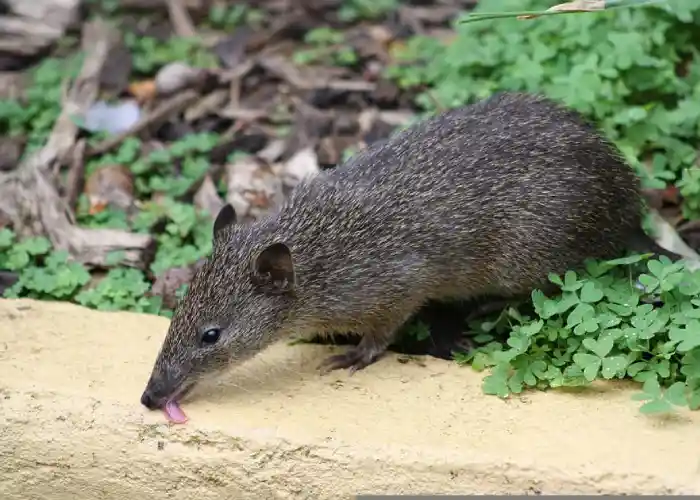
Size: 11-31 in
Weight: 0.4-3.5 lb
Diet: Omnivore
Found In: Australia
Bandicoots have v-shaped faces, ending with their prominent noses similar to proboscises. These noses make bandicoots similar in appearance to anteaters.
There are over 20 species of bandicoots. They range from small to medium-sized animals that are largely nocturnal (active during the night).
Bandicoots are marsupials, just like kangaroos. This means that their babies are only 0.5 inches long at birth. They got their name from the Telugu word “pandikokku,” which means “pig-rat.”
Hispaniolan Solenodon
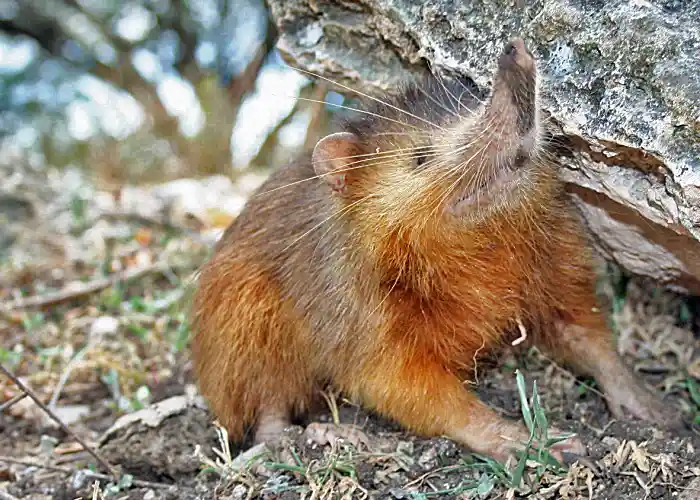
Size: 19-28 in
Weight: 1.76 lb
Diet: Carnivore
Found In: Caribbean island of Hispanola
One of only a few venomous mammals, the Hispaniolan solenodon lives exclusively on the island of Hispaniola in Haiti and the Dominican Republic.
The species got the name solenodon or “slotted-tooth” because this anteater-like animal injects venomous saliva into its prey through specialized grooves in the incisor teeth.
Hispaniolan solenodons have large heads with long snouts – this makes it easier to mistake them for anteaters.
Longnose Gar

Size: up to 6 ft 8 in
Weight: up to 35 lb
Diet: Carnivore
Found In: North and Central America
Also known as longnose garpike or billy gar, the longnose gar is a fish that looks similar to an anteater. Scientists estimate that this fish may have been present in North America for about 100 million years.
Longnose gar is a primitive-looking fish that has a long, spotted body and a slender beak-like snout that is nearly three times the length of its head.
Females are longer than males and both sexes continue to grow in size throughout their life.
Weevil

Size: 0.1- 0.4 in
Weight: /
Diet: Herbivore
Found In: Worldwide
Weevils are bugs that slightly resemble an anteater, mostly due to their body shape and a long down-curving snout. The long snout of these herbivorous beetles is called a rostrum.
There are about 97,000 species of weevils today and they are notorious for destroying plants, grains, and various types of food products. They do not attack humans or animals.
Spiny Softshell Turtle

Size: 7-20 in
Weight: 25 lb
Diet: Carnivore
Found In: North America
The spiny softshell turtle is a species of turtle that can be found in freshwaters of North America. It has a long and anteater-like nose. If you want to see the resemblance with anteaters, try focusing on the head and nose of the turtle.
What makes it different from other turtles is the soft, flat, and rubbery shell.
Read More: Animals that resemble meerkats
Elephant
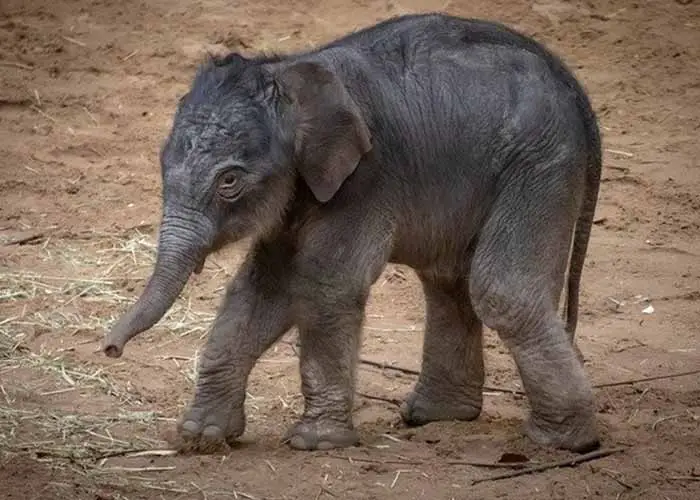
Size: 8.2-13 ft
Weight: 14,000 lb
Diet: Herbivore
Found In: Sub-Saharan Africa, South Asia, and Southeast Asia
Elephants, the world’s largest land animals, have long trunks, which makes them similar to anteaters. The elephant trunk is prehensile, has 40,000 muscles, and is used for smelling, breathing, trumpeting, drinking, and grabbing things.
Of course, you wouldn’t mistake an elephant for an anteater, but these animals still share some resemblances due to their trunk length and shape. Elephant calves are what reminded us the most of anteaters.
Read More: Do elephants hibernate or migrate?
Borzoi
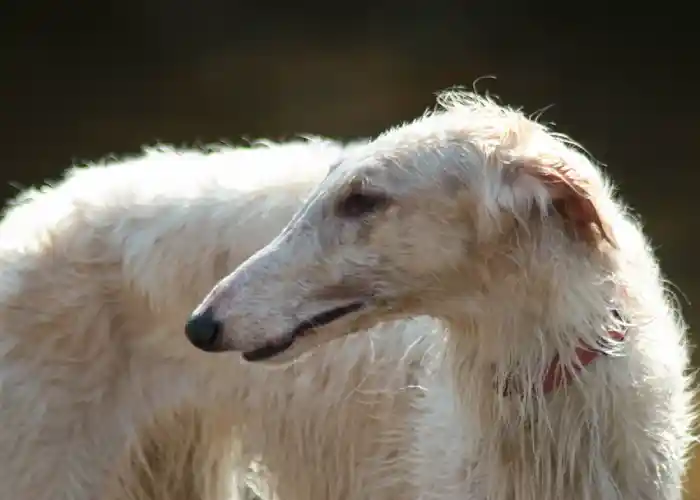
Size: 27-31 in
Weight: 55-105 lb
Diet: Omnivores
Found In:
This adorable breed of dogs reminds a lot of anteaters, mostly because of their ridiculously long snouts. One borzoi named Eris unofficially holds the world record with its 12.2 inches long snout.
Borzoi means ‘fast’ in Russian and these dogs had to rely on their speed, agility, and endurance to successfully hunt open country wildlife like wolves, foxes, and hares.
These dogs are very smart and highly affectionate which makes them a great choice as pets.
Elephant Seal

Size: 14-16 ft
Weight: 5,000 lb
Diet: Carnivores
Found In: North America
These large seals were almost hunted to the brink of extinction for oil by the end of the 19th century but managed to recover. They are the largest extant carnivores that can weigh up to 8,800 lb.
If you want to see the resemblance between an elephant seal and an anteater, look at their long snouts.
The elephant seal’s massive head is dominated by a large bulbous nose that droops over the mouth when relaxed. It resembles an elephant’s trunk, which is how the species got its name.
The nose serves as a megaphone to make loud sounds and assert dominance over rivals.
Saiga Antelope

Size: 24–32 in
Weight: 57–152 lb
Diet: Herbivore
Found In: Central Asia
Saiga antelope is the last on our list of animals that look like anteaters, mostly due to their long and weird-looking snouts.
To see similarities in looks between a saiga antelope and an anteater you might have to close one eye and squint on the other.
The nose that hangs over their mouth helps them filter out dust and cool their bodies down while crossing long distances during the summer.
They live in the dry steppe grasslands and semi-arid deserts of Central Asia and can run up to 50 mph.
Do you think that they are faster than llamas?
What Animals Are Related To Anteaters?
Anteaters include 4 species that belong to the order Pilosa (Latin for “hairy”). 2 members of that order are currently alive: anteaters and sloths. This means that the sloths are the anteaters’ closest relatives!
Sloths are most famous for their slow movement and spend most of their lives hanging upside down in the trees. Sloths can be found in the tropical rainforests of South and Central America.
Anteaters are also xenarthrans, they belong to the superorder Xenarthra – besides sloths, they are also related to armadillos.
It should be noted that all of these animals belong to different families – which means they are not extremely closely related. Nevertheless, they still share some relations and can be called anteater’s relatives.
Final Thoughts
There are many animals whose appearance can be compared to that of an anteater. Anteaters have long distinctive snouts, just like pangolins, aardvarks, armadillos, and many other animals.
Some look more alike to anteaters than others; sometimes, it just takes a bit more imagination to see the similarities in their looks.
Read more: Animals with huge and hilarious foreheads and Animals that closely resemble buffalos
Photo Credits:
Long-beaked echidna – Dega180, CC0, via Wikimedia Commons